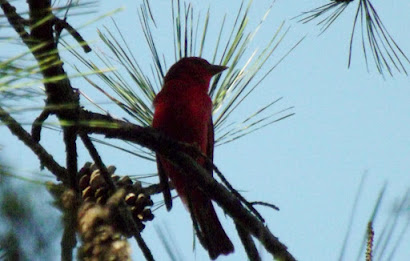While the Northern Cardinal is the most familiar “redbird” in southeastern North America, the region hosts another rosy-plumaged songbird species that is also quite common, if somewhat more secretive: the Summer Tanager. Catching a glimpse of one of these migratory birds may be difficult at times, but, if you learn to recognize their vocalizations, you may find them in a lot of places that you might not have expected. The main call of this species is a dry pik-i-tuk-tuk, while the song is a slurred, throaty warble—smoother than the more separated phrases of the American Robin. Because Summer Tanagers—and most tanager species, in general—tend to forage in the middle and upper branches of trees, seldom venturing close to the ground, the sounds that they make really are the most obvious signs of their presence in a given area. Mixed forests, particularly pine-oak woods, are the preferred habitats for this species.
If you do manage to spot a Summer Tanager after hearing its song or call, it’s generally pretty easy to tell whether the bird is male or female. Fully adult males have rose-red feathers all over. Adult females are more variable, and can be anywhere from a slightly greenish yellow to an orange-yellow with hints of red.
 |
| Female Summer Tanager |
Notice that I said it’s generally pretty easy to tell the sexes apart. Identification becomes slightly more complicated in the fall, when first-year males can have smatterings of red in their plumage or even an overall orangey appearance, just like female tanagers. However, the young males usually have more red on the undertail coverts than the adult females do, so it’s sometimes possible to tell them apart. Additionally, although some first-year female Summer Tanagers may look almost identical to some adult females, it’s more typical for them to be a bit drabber in color. At any rate, studying the variety of tanager plumages during the autumn season can be an interesting project! And, when spring rolls around and the tanagers return from their wintering grounds in Mexico, Central America, and the northern portion of South America, most of the young males will have plumage in a patchwork of red and yellow, as in the photos below. It takes another year for their yellow feathers to be completely replaced with red.
 |
| Preening immature male Summer Tanager |
 |
| Immature male Summer Tanager |
Summer Tanagers feed mainly on insects and fruit, and this is evident from the shape of their bills, which are stouter than those of exclusively insectivorous species, but slimmer than those of seed-eaters. Actually, most people should probably be thrilled to have tanagers around, since the birds’ favorite insects to consume are bees, wasps, and hornets! One of my earliest Summer Tanager sightings was of an adult male casually catching paper wasps high in a sweet gum tree in my backyard, and I’ve witnessed countless other tanager and hymenopteran interactions since then. If there isn’t too much ambient noise, then you can sometimes even hear the *SNAP* of a tanager’s bill as it closes on the bee or wasp. The tanager will then sometimes vigorously rub its prey against a tree branch before swallowing it whole and, later, regurgitating the tough, indigestible bits of insect exoskeleton. Yep, hawks and owls aren’t the only birds to produce pellets; most species do.
I have never seen an active Summer Tanager nest—perhaps surprisingly, considering how interested I am in birds’ nesting habits. However, monitoring a nest if I found one would probably not be too difficult, since tanagers prefer building on branches over open spaces and gaps in the woods. There would be minimal vegetation in the way! The usual number of eggs for the species is three to four, which are laid in a cup-shaped nest of grasses and leaves. Females do the incubating, but both parents feed the young throughout the nestling stage and for at least a few weeks after the fledging. Because Summer Tanagers are Neotropical migratory birds, developing survival skills during their first summer and autumn is crucial; after all, they don’t get any do-overs during that first grueling and hazardous journey to the wintering grounds. If they make it back to the breeding grounds in the spring, then they can start to claim nesting territories for themselves, continuing the cycle.
Although summer is nearly over, there are still plenty of opportunities to see Summer Tanagers in their breeding range before they depart around mid-October. Listen for the calls, watch for the wasp-catching behavior, observe the varied plumage patterns, and just enjoy the presence of our other “redbird.”
Source:Robinson, W. D. (2020). Summer Tanager (Piranga rubra), version 1.0. In Birds of the World (A. F. Poole, Editor). Cornell Lab of Ornithology, Ithaca, NY, USA.


